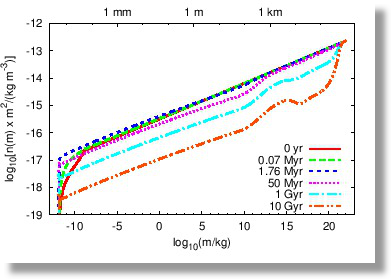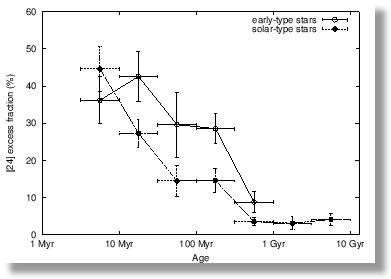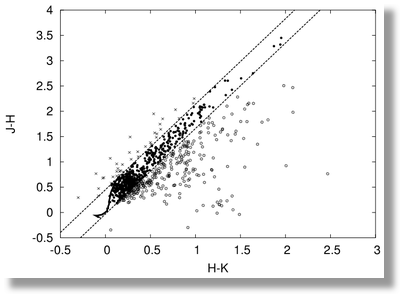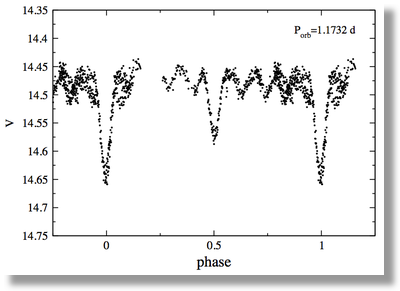Probing the innermost regions of Debris Disks with HST, Post-doctoral Researcher (2012 - 2014):
With our HST GO 12923 Cycle 20 investigation, we will push HST to its ultimate inner working angle (IWA)
limit for high-contrast imaging via coronagraphy, thereby enabling a new, technically demanding, but astrophysically
compelling, observational domain unique to Hubble and exploitable during the remaining years of the HST mission.
By quantitatively exploring, fully characterizing, and calibrating, the performance characteristics of the hereunto
untested STIS FINGER and BAR10 occulting masks (to be used for the first time on orbit), we seek to enable optical
coronagraphy at IWAs as small as 0.15". The figure to the right illustrates the improved choronagraphic capabilities,
with white circles representing the proposed r=0.15" IWA.
Collaborators: Dr. Glenn Schneider (Steward), Dr. Daniel Apai (Steward), Dr. Dean Hines (STScI), Dr. John Debes (STScI),
Dr. Charles Profitt (STScI), Prof. George Rieke (Steward), Dr. Ted Gull (GSFC)
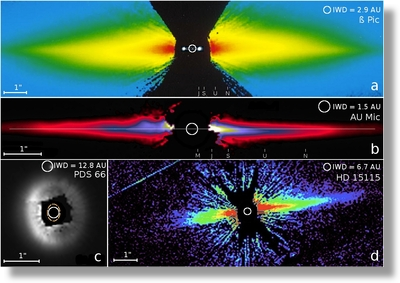
Theoretical Modeling of Debris Disks, Graduate Research Assistant (2009 - 2011),
Postdoctoral Researcher (2011-2013):
We develop a new numerical algorithm to model collisional cascades in
debris disks. Because of the large dynamical range in particle masses,
we solve the integro-differential equations describing erosive and
catastrophic collisions in a particle-in-a-box approach, while
treating the orbital dynamics of the particles in an approximate
fashion. We employ a new scheme for describing erosive (cratering)
collisions that yields a continuous set of outcomes as a function of
colliding masses. We show that incorporating the effects of erosive
collisions results in a decay of the particle distribution that is significantly faster
than with purely catastrophic collisions.
Supervisors: Prof. Dimitrios Psaltis (Steward), Prof. Feryal Özel (Steward),
Prof. George Rieke (Steward)
Debris Disks in Open Clusters, Graduate Research Assistant (2008 - 2009):
We perform 24 μm photometry of the intermediate-age open cluster Praesepe. Mid-IR excesses
indicating debris disks were found for one early-type and for three solar-type stars. Corrections
for sampling statistics yield a 24 μm excess fraction (debris disk fraction) of 6.5±4.1% for
luminous and 1.9±1.2% for solar-type stars.
We showed that solar-type stars lose their debris disk 24 μm excesses on a shorter timescale than
early-type stars (see Figure). Simplistic MC models suggest that, during the first Gyr of their
evolution, up to 15-30% of solar-type stars might undergo an orbital realignment of giant planets.
We also determine the cluster's parameters, yielding an age of 757 Myr (± 36 Myr) and a
distance of 179 pc (± 2 pc), not allowing for systematic errors.
Supervisors: Prof. George Rieke (Steward), Dr. Kate Y. L. Su (Steward)
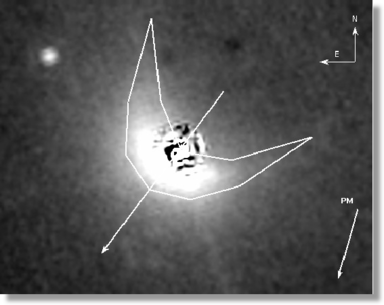
Stellar-ISM Interactions, Graduate Research Assistant (2006 - 2008):
We discovered a bow shock shaped mid-infrared excess region in front
of δ Velorum using 24 μm observations obtained with MIPS. Although
the bow shock morphology was only detected in the 24 μm observations,
its excess was also resolved at 70 μm. We show that the stellar heating of
an ambient interstellar medium (ISM) cloud can produce the measured flux.
Since δ Velorum was classified as a debris disk star previously,
our discovery may call into question the same classification of other stars. We model
the system, producing images that show the same geometry and surface
brightness as is observed. The modeled ISM is 15 times overdense relative
to the average Local Bubble value.
The abundance anomalies of λ Bootis stars have been previously explained
as arising from the same type of interaction of stars with the ISM. Low resolution optical
spectra of δ Velorum show that it does not belong to this stellar class. The
star therefore is an interesting testbed for the ISM accretion theory of the λ
Bootis phenomenon.
Supervisors: Dr. Kate Y. L. Su (Steward), Prof. George Rieke (Steward)
Science Verification of UKIDSS Galactic Plane Survey, Visiting Research Assistant (Summer of 2005):
I worked on the Science Verification of the United Kingdom Infrared Deep Sky Survey's Galactic Plane
Survey part by analyzing images of M17 at the School of Physics & Astronomy, in Leeds, UK. I analyzed
the ZP of the photometry system by perfoming high precision photometry on M17 and I also produced Near-IR
extinction maps of M17.
Supervisor: Prof. Melvin G. Hoare (Leeds, UK)
Embedded Young Open Clusters, Undergraduate Research Assistant (2003 - 2006):
I developed an IRAF Near-IR reduction pipeline for FLAMINGOS, which was used to
analyze MMT data on NGC 7538. Over 9000 NIR sources were found on the combined map
of the FOV, which was used to search for stellar density peaks and to determine the
K-band luminosity function, which hinted at a total cluster mass that is comparable
to the Orion Nebula's.
I also analyzed NIR survey data of young embedded open clusters taken with the 1.2m
telescope on Mt. Hopkins. Over 20 clusters were observed in the NIR wavelengths,
yielding similar estimators as for NGC 7538.
Supervisor: Dr. Zoltán Balog (MPIE, Heidelberg)
Variable stars in Open Clusters, Undergraduate Research Assistant (2001 - 2003):
We present the first CCD photometric observations of the northern open cluster NGC 2126. Data were taken on
eight nights in February and December 2002 with a total time span of 57 hours. Almost 1000 individual V-band
frames were examined to find short-period variable stars. We discovered six new variable stars, of which one
is a promising candidate for an eclipsing binary with a pulsating component. Two stars were classified as δ
Scuti stars and one as Algol-type eclipsing binary. Two stars are slow variables with ambiguous classification.
From absolute V(RI)C photometry we have estimated the main characteristics
of the cluster: m-M = 11.0±0.5 mag, E(V-I)=0.4±0.1 mag, E(V-R)=0.08±0.06 mag,
and d = 1.3 ± 0.6 kpc. Cluster membership is suggested for three variable stars from their positions
on the colour-magnitude diagram.
Supervisor: Dr. László L. Kiss (Konkoly)

